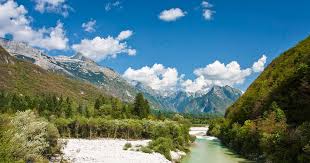Alternative Alps: Exploring the Stunning Julian Alps of Slovenia.
Alternative Alps: Exploring the Stunning Julian Alps of Slovenia.

When people dream of majestic alpine escapes, their minds often wander to the snow-kissed peaks of Switzerland, Austria, or France. But tucked away in the heart of Central Europe lies a breathtaking alternative that’s still blissfully underexplored: the Julian Alps of Slovenia.
This mountain range, part of the broader Southern Limestone Alps, is a jewel of the Balkans. With dramatic ridgelines, pristine lakes, hidden valleys, and traditional alpine culture, the Julian Alps offer a fresh perspective on mountain tourism—uncrowded trails, wallet-friendly experiences, and a deep sense of natural tranquility.
Where Are the Julian Alps?
Located in the northwestern corner of Slovenia, the Julian Alps form a large part of Triglav National Park, the country’s only national park. Named after Mount Triglav—the highest peak in Slovenia at 2,864 meters—the park stretches across verdant forests, turquoise rivers, and alpine meadows, all under the watchful gaze of rugged cliffs.
Bordering Italy and close to Austria, the Julian Alps are accessible but never overrun. Ljubljana, the Slovenian capital, is just a couple of hours away by road, making it a convenient starting point for travelers.
A Paradise for Hikers and Nature Lovers
The Julian Alps are a hiker’s dream. From leisurely lakeside strolls to multi-day alpine hut treks, there’s a trail for every fitness level. The Slovenian Mountain Trail, Europe’s oldest long-distance trail, winds through these mountains, offering a remarkable way to immerse yourself in unspoiled landscapes.
Mount Triglav: Slovenia’s Pride
Climbing Mount Triglav is more than a physical journey—it’s a cultural rite of passage. Slovenians believe that every citizen should summit it at least once in their lifetime. While the climb requires a good level of fitness and some technical experience (especially near the summit via ferrata section), the payoff is panoramic views over Slovenia, Italy, and Austria. Guided tours and overnight stays at mountain huts like Planika or Kredarica make the ascent more manageable and enriching.
Lake Bohinj: The Hidden Alpine Gem
While Lake Bled often steals the spotlight with its picturesque church on an island, Lake Bohinj—just a short drive away—offers a more peaceful and wild setting. Nestled within Triglav National Park, it’s the largest permanent lake in Slovenia, surrounded by steep mountains and ancient forests.
Visitors can swim in its crystal-clear waters, kayak across the lake, or hike up to Vogel Mountain via cable car for incredible aerial views. Unlike its more commercial cousin Bled, Bohinj still feels authentic—there are fewer crowds, more opportunities for wildlife encounters, and a stronger connection with nature.
Soca Valley: Where Turquoise Rivers Flow
Flowing from the Julian Alps to the Adriatic Sea, the Soča River is famous for its intense emerald hue. This valley is not only postcard-perfect but also a hub for outdoor adventure.
White-water rafting, kayaking, and canyoning attract adrenaline seekers, while photographers are drawn to the river’s unique color and backdrop of jagged peaks. The Soča Trail, a 25-km hiking path, follows the river’s journey from its source through alpine meadows and gorges.
Also noteworthy is the region’s rich history—World War I battles were fought here, particularly around the Isonzo Front, and open-air museums still bear witness to the past.
Picturesque Villages and Local Culture
Slovenia’s alpine villages exude charm. Kranjska Gora, located near the Austrian and Italian borders, offers cozy lodges, friendly locals, and easy access to skiing in winter and hiking or biking in summer. It’s a great base for exploring Vršič Pass, a serpentine road with jaw-dropping views and historical significance.
Another gem is Mojstrana, home to the Slovenian Alpine Museum, which tells stories of mountaineering traditions and local legends. Villages in the Julian Alps are steeped in folk culture, with rustic architecture, handmade crafts, and hearty cuisine.
Speaking of food—Slovenian alpine meals are simple but flavorful. Think mushroom soups, barley stews, wild game, and dumplings known as žganci. Pair them with a glass of local schnapps or mountain herbal tea, and you’ve got a comforting alpine feast.
Seasons of Beauty
The Julian Alps change their personality with the seasons. In spring, melting snow feeds waterfalls and paints the meadows with wildflowers. Summer brings ideal hiking conditions, while autumn cloaks the landscape in fiery golds and oranges. Winter transforms the region into a snow-covered wonderland, perfect for skiing, snowshoeing, or enjoying a quiet retreat in a mountain cabin.
Unlike the crowded resorts in the Western Alps, Slovenia’s ski resorts—such as Vogel, Kanin, or Krvavec—maintain a laid-back atmosphere and reasonable prices.
Sustainability and Accessibility
Slovenia has made impressive strides in sustainable tourism. Triglav National Park is protected under strict environmental regulations, and visitors are encouraged to follow the Leave No Trace ethos. Public transport options like the Bohinj Railway and summer shuttles help reduce vehicle congestion and emissions in sensitive areas.
The country is also incredibly tourist-friendly. English is widely spoken, signage is clear, and prices are moderate compared to alpine hotspots in Switzerland or Italy. This makes the Julian Alps a perfect choice for travelers seeking off-the-beaten-path experiences without sacrificing comfort or safety.
Why Choose the Julian Alps?
The Julian Alps are for those who seek authenticity, solitude, and a deeper connection with nature. You won’t find five-star resorts or celebrity chefs here—but you will find endless trails, jaw-dropping scenery, and a welcoming culture grounded in tradition.
Whether you’re a seasoned alpinist, a family looking for a nature getaway, or a solo traveler craving quiet moments in the mountains, this underrated alpine region will reward you with memories that linger long after your boots are off.
Final Thoughts
Slovenia’s Julian Alps are not just an alternative to the classic Alps—they’re an adventure of their own, deserving of center stage. So if you’ve already done Chamonix, Zermatt, or Innsbruck, it might be time to chart a new course—one that leads to turquoise rivers, peaceful trails, and sunrises from the summit of Triglav.
Travel slowly, breathe deeply, and let the Julian Alps enchant you one peak at a time.


